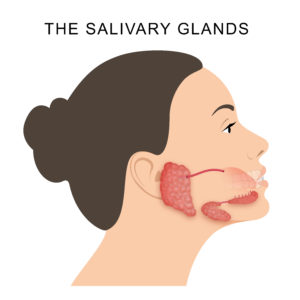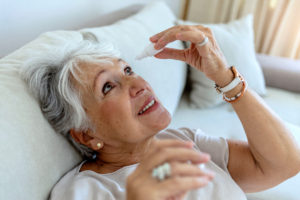

Natural Solutions For Sjogren's Syndrome
Watch Dr Cabot's video "Sjogren's Syndrome" on YouTube HERE.
Sjogren’s syndrome is not a rare disorder with an incidence of 0.5% to 1.0% of the population. It is approximately half as common as rheumatoid arthritis. Sjogren’s Syndrome was named after Dr Henrik Sjogren (1899-1986) who was a Swedish eye specialist and first described it.

Sjogren’s Syndrome is an autoimmune disorder which causes the immune system to attack the salivary glands, the eye’s tear glands (lacrimal glands) and the mucous membranes. Mucous membranes line the mouth, the nose and sinuses, the intestines, the bladder and the vagina and the eyes.
The glands become damaged and are not able to produce enough saliva, tears, nasal secretions, and intestinal secretions. The mucous membranes become dry and damaged and are not able to make enough protective mucus or secretions.
The outstanding problem is dryness of the eyes, mouth, nose, and skin. The eyes can feel dry, gritty, and irritated. The skin may be dry and itchy.
The vagina may become very dry causing sexual dysfunction. It may become hard to chew and swallow and the sense of taste may be diminished so food is not enjoyed as much. The lack of saliva causes gum problems and tooth decay.
There is excess inflammation in the body and other organs may be affected by Sjogren’s Syndrome including the muscles, lungs, and pancreas. Painful muscles and a cough may develop.
If the pancreas gland is affected there can be a deficiency of digestive enzymes produced by the pancreas. This can lead to poor digestion and nutritional deficiencies. The pancreas is an exocrine gland with a similar structure and function to the salivary glands, so it is not surprising that the pancreas can be attacked in Sjogren's patients. Patients with Sjogren’s Syndrome have an increased risk of acute pancreatitis, and the elevated IgG4 serum levels in these patients increased the prevalence of autoimmune chronic pancreatitis. The disease can also attack the bile ducts causing cholangitis.
Sjogren’s Syndrome is a very unpleasant disease and thankfully there is much that can be done to relieve the symptoms and reduce the inflammation. The earlier Sjogren’s Syndrome is treated the easier it is to repair the damage, Diagnosis may be delayed with health professionals thinking the patient just has dry eyes and mouth and not recognizing the cause or severity of the problem. It is often first diagnosed by an optometrist or a dentist.
Sjogren’s Syndrome is associated with a higher incidence of other autoimmune diseases such as rheumatoid arthritis, thyroid disorders, scleroderma and lupus.
Tests for Sjogren’s Syndrome
- There is no single test that will confirm the diagnosis of Sjögren's Syndrome and doctors must use several tests and take a thorough medical history about all the symptoms the patient is experiencing.
- Blood tests: SS-A and SS-B are marker antibodies for Sjögren’s. Seventy percent of Sjögren’s patients are positive for SS-A and 40% are positive for SS-B; these antibodies are also found in most lupus patients.
- Salivary Flow Test: Measures the amount of saliva produced over a certain period of time.
- Schirmer’s test: an eye doctor measures the amount of tears your lacrimal glands produce.
- Rose Bengal and Lissamine Green Test: administers dyes to the eyes to examine the surface of the eyes for dry spots.
- Salivary Gland Biopsy(usually in the inner lower lip): The biopsy involves the removal of a small amount of tissue containing tiny salivary glands that is examined under a microscope. This shows lymphocytic infiltration of the minor salivary glands. Lymphocytes are a type of white blood cell that attacks the glands.
Treatment of Sjogren’s Syndrome
It is important to see an eye specialist (ophthalmologist) and a dentist regularly to ensure the best care for your eyes and to prevent dental caries that are caused by lack of saliva.
Conventional treatments focus on treating the symptoms and include:
 Artificial tears to put in the eyes
Artificial tears to put in the eyes- Immunosuppressant tear drops containing the drug cyclosporin
- Immunosuppressant drugs such as hydroxychloroquine
- Medications such as pilocarpine to increase production of saliva
- Large contact lenses called a scleral lens prosthesis to protect the eyes from drying out
- Serum tears that can be made from the patient’s blood
- Sugar free gum containing xylitol
These treatments may greatly improve the quality of life.
Nutritional Medicine focuses on treating the cause of the disease and includes:
Diet
What you eat has a huge effect on your immune system and inflammation. I recommend what is called an autoimmune diet and this is discussed in my book titled HEALING AUTOIMMUNE DISEASE. To start with exclude all grains (wheat, rye, barley, oats, rice, and corn) and processed foods from your diet. Most people with Sjogren’s Syndrome are intolerant to gluten and this is so even if they are not a coeliac sufferer. Gluten should be avoided and is found in many grains and processed foods and sauces. See my book titled GLUTEN IS IT MAKING YOU SICK OR FAT?
A diet that contains plenty of healthy fats is important as good fats moisturize the gut and mucus membranes. Good fats are found in grass fed meat, poultry, seafood (especially oily fish such as sardines), eggs, butter, olive oil, coconut oil and cream, avocado and nuts.
Beneficial foods for Sjogren’s Syndrome include Sauerkraut and broccoli sprouts as these help the gut microbiome and the liver.
Supplements for Sjogren’s Syndrome
If you have pancreatic insufficiency you will need digestive enzymes in the middle of meals or you will not absorb fat and protein and will become malnourished.
Make sure that you are producing enough bile as bile is needed to absorb dietary fats and fat-soluble vitamins. Deficiency of fat-soluble vitamins will make Sjogren’s Syndrome much worse. If you are bile deficient you will be intolerant to dietary fat and you will have pale feces (stools). If you have bile insufficiency, I recommend you take ox bile capsules – one in the middle of meals that contain fat. See my videos on the gallbladder.
Fat – soluble vitamins
Fat-soluble vitamins can reduce dryness of all the mucus membranes. They can also reduce inflammation and repair damaged mucus membranes.
I recommend you take the following fat-soluble vitamins:
Vitamin A (retinol) 5,000 IU daily with food.
Super Vitamin K in a dose of 2 capsules daily with food – these capsules also contain a good dose of vitamin D as well as K
Vitamin D to keep your blood levels of vitamin D in the upper limit of the normal range
Vitamin E 500 IU Daily and eat avocado as it’s high in vitamin E
Cod liver oil and lamb’s liver (lamb’s fry) are also excellent sources of these fat-soluble vitamins.
A fish oil supplement is most worthwhile to boost omega 3 fatty acids which are anti-inflammatory for the whole body and reduce dryness. Take it with meals.
Selenomune is an excellent supplement for autoimmune conditions and balances the immune system. It can reduce the levels of the antibodies that attack the glands and mucus membranes. It can also help to fight viruses and some researchers think that hidden chronic viral infections can trigger Sjogren’s Syndrome. Selenomune contains 3 types of organic selenium, iodine, zinc, activated vitamin B 12 and other immune nutrients. The dose is one capsule daily.
N-Acetyl-Cysteine (NAC) increases the production of glutathione by the liver. Glutathione is the most powerful antioxidant produced by the body to reduce inflammation and repair damaged tissues. NAC is helpful for the eyes and gums and reduces dental plaque. The dose of NAC is one to two capsules twice daily in between meals with a whole large glass of water.
These supplements may take 4 to 6 months to exert their full benefit and need to be taken regularly. Improvement occurs gradually as it takes longer to treat the cause of a disease than it does to just treat the symptoms.
Oil pulling: this is an old traditional habit in Asia used to cleanse, detoxify and moisturize the mouth and works quite well.

Coconut oil has anti-inflammatory and anti-microbial effects and can be used daily. Place one tablespoon of coconut oil in your mouth and hold it in your mouth for 15 to 20 minutes. Then spit the oil out in the bin. This is good to do before retiring at night but some people do it more frequently with good effect.
Castor oil: this is excellent to rub into your eyes before sleep and can be used more frequently. This reduces eye discomfort prevents the eyes from drying out as much. Try to purchase organic castor oil. It is soothing and moisturising to the eyes and is non-irritating.
Hormone Therapy: Sjogren’s Syndrome is nine times more common in women than men and often gets much worse when a woman becomes menopausal and post-menopausal. This is a big clue that the sex hormones estrogen, progesterone and testosterone play a role in this disease.
Researchers have shown that male hormones (androgens) play an important role in regulating the function of both the salivary (lacrimal) and eye (meibomian) glands. These researchers proved that artificial tears with added testosterone were effective in relieving dry eyes. They also trialled a transdermal cream with 3% testosterone which greatly improved dry eyes. Post-menopausal females perceived the greatest relief of symptoms from the treatment, while males had the least benefit.
It is worth having a blood test to check your levels of testosterone both total and free amounts, and if they are very low you can also use testosterone troches or capsules or apply a testosterone cream to your vulva or armpits. This will raise blood levels of testosterone and may reduce dryness of the eyes and mouth substantially.
If you suffer with vaginal dryness and discomfort, a cream containing a combination of bio-identical natural estrogen, progesterone and testosterone can be inserted into the vagina or applied to the vulva. Such a cream may help the dryness in the eyes and mouth as well as the vaginal dryness. A doctor’s script is required.
Sjogren’s Syndrome is a very distressing autoimmune disease, but the use of holistic medicine enables patients to control the symptoms and treat the cause, often with excellent results.
References
Treatment of Dry Eye with a Transdermal 3% Testosterone Cream, Ophthalmology & Visual Science May 2003, Vol.44, Issue 13, 2450.
The correlation between selenium levels and autoimmune thyroid disease: a systematic review and meta-analysis. Annals of Palliative Medicine. Vol 10, No 4 (April 30, 2021)
Selenium Supplementation in Patients with Autoimmune Thyroiditis Decreases Thyroid Peroxidase Antibodies Concentrations Roland Gärtner, et al, The Journal of Clinical Endocrinology & Metabolism, Volume 87, Issue 4, 1 April 2002, Pages 1687–1691 https://doi.org/10.1210/jcem.87.4.8421
The immunoregulatory role of vitamins A, D and E in patients with primary Sjögren’s syndrome. Peter Szodoray, et al, Rheumatology, Volume 49, Issue 2, February 2010, Pages 211–217, https://doi.org/10.1093/rheumatology/kep374
The above statements have not been evaluated by the FDA and are not intended to diagnose, treat or cure any disease.
Know someone who might benefit from this article? Share it!
2 Comments
Need Help?
1-888-75-LIVER
Monday to Friday, 9:00 am to 5:00 pm MST
100%
Satisfaction Guaranteed
If it’s faulty or wrongly described, we’ll replace it.











So very informative.
Here is a video on Sjogren's Syndrome.
Its a great video.
Thanks for your gratitude
Cheers
Dr Sandra Cabot